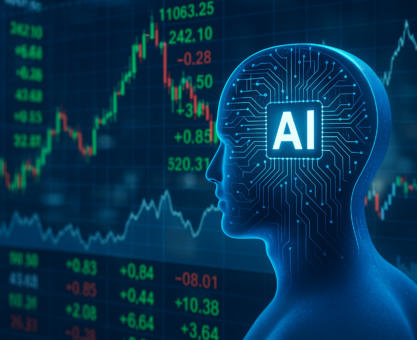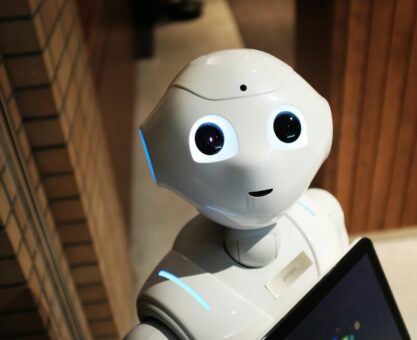Top 10 AI Tools Revolutionizing Software Development in 2025
Artificial Intelligence (AI) is rapidly reshaping the world of software development, and 2025 promises to bring even more groundbreaking innovations. From automating mundane tasks to enhancing code quality, AI tools are becoming indispensable for developers looking to improve their workflows and increase productivity. With the growing demand for faster, more efficient development cycles, AI-powered solutions are at the forefront of this transformation.
In this article, we’ll explore the top 10 AI tools that are revolutionizing software development in 2025. These tools range from code assistants that help you write clean and efficient code, to AI-driven testing tools that ensure your software meets the highest standards of quality. Whether you’re a seasoned developer or just getting started, these AI tools are here to make your development process smarter, faster, and more reliable.
Stay tuned as we dive into the best AI-powered solutions that can help you streamline your workflow, automate repetitive tasks, and ultimately, build better software in less time.
AI-Powered Code Assistants
AI-powered code assistants are one of the most transformative tools for developers in 2025. These tools use advanced machine learning algorithms and natural language processing (NLP) to help developers write code faster, more efficiently, and with fewer errors. By providing context-aware code suggestions, these assistants save developers countless hours of work and ensure cleaner, more optimized code.
Here are some of the top AI-powered code assistants that are making a significant impact in the software development world:
- GitHub Copilot – Developed by GitHub and OpenAI, Copilot is a revolutionary tool that offers real-time code suggestions directly in your Integrated Development Environment (IDE). It can generate entire functions, debug code, and assist with documentation. GitHub Copilot is designed to speed up the development process while enhancing code accuracy and quality.
- Kite – Kite is an AI-powered coding assistant that integrates seamlessly with popular code editors such as VS Code, Atom, and Sublime Text. By offering autocompletion suggestions and intelligent documentation, Kite helps developers write Python, JavaScript, and other languages more efficiently, reducing the time spent on repetitive coding tasks.
- Tabnine – Tabnine uses GPT-based technology to provide intelligent code completions for developers. It works with various languages, including Python, JavaScript, Go, and Java, offering real-time suggestions that improve coding efficiency. Tabnine’s ability to understand context and suggest entire code blocks makes it a great productivity booster for developers.
These AI-powered code assistants not only speed up the coding process but also help developers improve the quality of their code. By leveraging machine learning to understand context and anticipate code requirements, they make writing code a more intuitive and streamlined experience. Whether you’re working on a complex project or a simple script, these tools can significantly reduce your workload.
Automated Software Testing Tools
Automated software testing has become an essential part of the development process in 2025, and AI-powered testing tools are at the forefront of this transformation. These tools utilize machine learning and advanced algorithms to automate repetitive testing tasks, improve test coverage, and detect bugs early in the development cycle. By incorporating AI into testing, developers can focus more on building features while ensuring the software remains reliable and error-free.
Here are some of the leading AI-powered automated software testing tools that are revolutionizing the industry:
- Testim.io – Testim.io leverages AI to automate the creation, execution, and maintenance of functional tests. Its smart, machine-learning algorithms analyze your application to generate and execute tests, even adapting to changes in the application’s UI. This reduces the time required for manual testing while increasing test accuracy and reliability.
- Applitools – Applitools uses visual AI to automatically detect UI bugs, ensuring that applications appear correctly across multiple devices and screen sizes. It captures screenshots of your application’s UI and compares them with baseline images, instantly identifying visual discrepancies that could impact the user experience.
- Mabl – Mabl is an intelligent test automation platform that uses AI to streamline the testing process. It automatically creates tests by learning how users interact with the application, ensuring that the most important use cases are covered. Mabl also provides detailed insights and reports, allowing teams to quickly identify performance issues and bugs.
AI-powered testing tools like these are invaluable for improving the efficiency and accuracy of testing, reducing the manual effort required for quality assurance, and ensuring a smooth user experience. By automating the testing process, developers can quickly identify bugs, optimize performance, and deploy software faster with confidence.
AI for Continuous Integration and Delivery (CI/CD)
Continuous Integration and Delivery (CI/CD) are key practices in modern software development, helping teams to deliver software faster and with fewer bugs. By automating the integration and deployment pipelines, these practices enable developers to focus more on writing quality code rather than worrying about manual testing or deployment procedures. In 2025, AI is playing a pivotal role in enhancing CI/CD processes, making them more efficient, smarter, and faster.
AI-driven CI/CD tools use machine learning algorithms to optimize the entire pipeline, from code integration and testing to deployment. These tools can predict potential failures, automatically trigger builds, and intelligently manage test coverage to ensure that the right tests are executed at the right time. Below are some of the top AI tools that are improving CI/CD processes:
- CircleCI – CircleCI leverages AI and machine learning to improve the efficiency of CI/CD pipelines. By analyzing previous builds and deployments, CircleCI can optimize the workflow, predict potential issues, and suggest changes to improve the pipeline’s performance. The AI-driven insights help teams make data-driven decisions and quickly resolve bottlenecks.
- Travis CI – Travis CI is another popular CI/CD tool that integrates with GitHub and uses AI to streamline deployment processes. It uses intelligent algorithms to manage build prioritization, detect errors, and provide developers with faster feedback. Travis CI’s AI capabilities help optimize the entire CI/CD lifecycle, from integration to deployment.
- Harness – Harness uses AI for Continuous Delivery, providing an intelligent and automated approach to software deployments. The platform incorporates AI to automatically detect anomalies in the deployment pipeline, ensuring that new versions of software are pushed to production without any disruptions. Harness also automates rollbacks when issues are detected, minimizing downtime and improving release confidence.
Integrating AI into CI/CD pipelines allows development teams to automate more of the deployment process, reduce manual intervention, and ensure that software is delivered faster and more reliably. With AI-powered CI/CD tools, developers can identify bottlenecks, predict failures, and improve the overall quality of the deployment process, making them essential for teams looking to stay competitive in today’s fast-paced development environment.
Code Refactoring with AI
Code refactoring is the process of restructuring existing code without changing its external behavior. It’s a crucial aspect of maintaining clean, efficient, and scalable code in software development. However, traditional manual refactoring can be time-consuming and error-prone. In 2025, AI tools are revolutionizing the code refactoring process, making it faster, more accurate, and easier to implement.
AI-powered refactoring tools use advanced algorithms to analyze your code, identify potential improvements, and suggest optimized solutions. These tools can refactor large codebases automatically, enhance readability, and ensure better performance, all while reducing the risk of introducing new bugs. Here are some of the top AI tools transforming the refactoring process:
- Refactoring.Guru – Refactoring.Guru provides a collection of patterns and techniques that are powered by AI to help developers identify code smells and improve the design of their software. The platform’s intelligent algorithms can automatically refactor legacy code, improving readability, maintainability, and scalability without introducing bugs.
- Codacy – Codacy is an AI-powered code review tool that not only analyzes code for issues but also provides suggestions for refactoring. It checks for code quality, style issues, and areas that can be improved for performance. Codacy uses AI to learn from past reviews and continuously improve its refactoring suggestions.
- IntelliJ IDEA – IntelliJ IDEA, a popular integrated development environment (IDE), incorporates AI to provide smart code refactoring suggestions. It helps developers by automating common refactoring tasks, such as renaming variables or extracting methods, and ensuring that the refactor does not break any existing functionality.
AI-powered code refactoring tools make it easier to maintain high-quality code, reduce technical debt, and streamline the development process. By automating the refactoring process, developers can focus on adding new features and solving complex problems, while leaving the tedious and repetitive tasks to AI. Whether you’re working on legacy code or optimizing new projects, these tools help you ensure that your codebase remains clean, efficient, and easy to maintain.
AI for Software Design and Architecture
In 2025, AI is playing an increasingly important role in software design and architecture, helping developers create scalable, efficient, and robust systems. Traditionally, software design has been a complex and time-consuming process that requires deep knowledge and experience. However, AI tools are now assisting developers in designing the architecture of their applications by analyzing system requirements, recommending architectural patterns, and even predicting the potential impact of design decisions.
AI-powered software design and architecture tools use machine learning to automate many aspects of the design process, helping developers optimize performance, reduce technical debt, and improve the overall system structure. By providing intelligent suggestions and automating repetitive tasks, these tools enable faster development while ensuring that the software remains maintainable and scalable. Here are some of the leading AI tools in this space:
- Architectural Decision Records (ADR) – ADR tools, powered by AI, help document and manage software architecture decisions. AI can analyze various system parameters, such as scalability, security, and performance, and suggest the most appropriate architecture patterns. These tools not only assist developers in making informed decisions but also ensure that architectural choices are well-documented for future reference and maintenance.
- Structurizr – Structurizr is an AI-driven tool for visualizing and documenting software architecture. It automatically generates architectural diagrams based on the system design and helps developers better understand the relationships between different components of the system. By using machine learning to analyze the design, Structurizr can offer insights into potential improvements in system structure and performance.
- UMLet – UMLet is a lightweight UML tool that leverages AI to enhance the software modeling process. AI assists by automatically generating UML diagrams based on the codebase, enabling developers to visualize complex systems more easily. This tool simplifies the process of creating and maintaining architectural diagrams, reducing manual effort and ensuring that the system design is always up-to-date.
AI-powered tools for software design and architecture are helping developers overcome the challenges of designing complex systems. By automating key aspects of the design process and providing intelligent insights, these tools ensure that applications are built with the best possible architecture. With AI, developers can create software that is more scalable, maintainable, and optimized for performance, all while reducing time spent on design tasks.
AI for Project Management in Software Development
Project management in software development involves overseeing the planning, execution, and delivery of projects within a set timeline and budget. In recent years, AI has made significant strides in transforming project management by automating routine tasks, predicting project risks, optimizing resources, and offering real-time insights. By leveraging AI, software development teams can streamline project workflows, enhance collaboration, and improve overall efficiency.
AI-powered project management tools use machine learning algorithms and data analytics to provide actionable insights into project timelines, resource allocation, and team productivity. These tools help project managers anticipate potential roadblocks, adjust schedules, and ensure that projects are delivered on time and within budget. Below are some of the leading AI tools revolutionizing project management in software development:
- Monday.com – Monday.com is an AI-powered project management platform that helps development teams manage tasks, timelines, and resources efficiently. The AI-driven tool provides insights on project performance, predicts potential delays, and offers recommendations to optimize workflows. By analyzing historical project data, Monday.com helps project managers make data-driven decisions to keep projects on track.
- ClickUp – ClickUp is an AI-enhanced project management tool that offers a range of features designed to automate and streamline tasks. With its AI capabilities, ClickUp can prioritize tasks, provide real-time feedback on project progress, and alert teams to any potential issues before they become critical. The tool’s AI-powered reporting system also allows project managers to quickly assess project health and adjust resources accordingly.
- Jira by Atlassian – Jira, a popular tool for agile project management, integrates AI to improve team collaboration and task management. AI in Jira helps automatically prioritize tasks, identify dependencies, and predict the likelihood of delays. This allows development teams to stay proactive and ensure projects are completed with minimal disruptions.
By integrating AI into project management, software development teams can significantly reduce the time spent on manual project tracking, reporting, and decision-making. AI tools help project managers identify risks early, allocate resources more effectively, and ensure better communication across the team. As AI continues to evolve, it will further enhance the ability to manage software development projects, making them more efficient and successful.
Conclusion
As we move further into 2025, AI continues to reshape the landscape of software development. From enhancing code quality to optimizing project management and streamlining design processes, AI tools are becoming indispensable in the development lifecycle. By leveraging these AI-powered tools, software development teams can achieve higher efficiency, reduce errors, and ensure that projects are delivered on time and within budget.
AI is not only automating repetitive tasks but also providing developers with deeper insights and smarter decision-making capabilities. Whether it’s through intelligent code refactoring, automated testing, or optimized project management, AI is unlocking new possibilities for developers and businesses alike. As AI technology continues to advance, it will play an even greater role in revolutionizing how software is built and maintained.
The future of software development is undeniably tied to AI, and those who embrace these tools today will be better equipped to stay competitive in an ever-evolving industry. By staying ahead of the curve and adopting the best AI tools available, software developers can drive innovation and deliver exceptional products that meet the needs of tomorrow.








